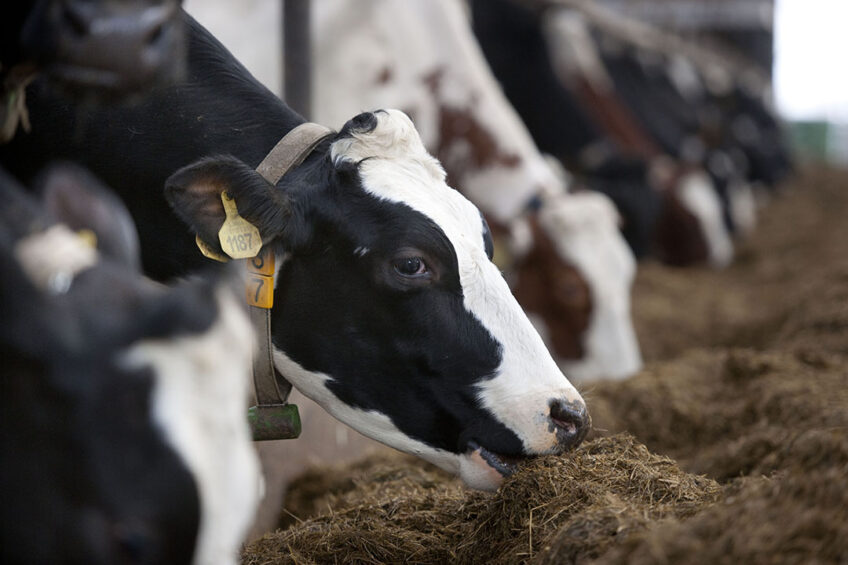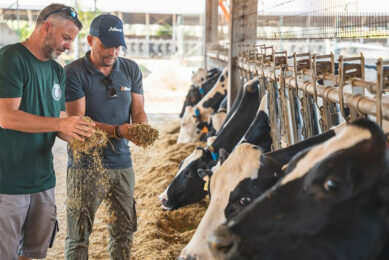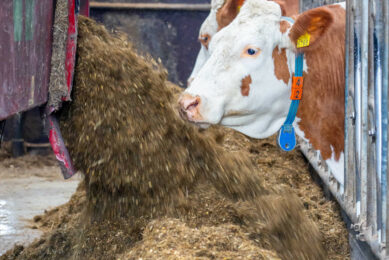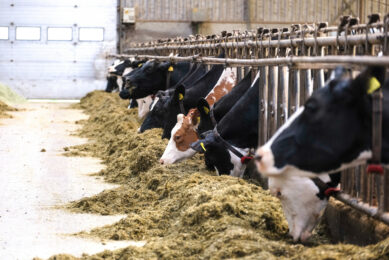Advantages of group feeding of dairy cows

Group feeding of cows is a system that is adopted in many dairy farms worldwide. The system has several advantages in terms of animal performance and financial savings. Several management factors, including grouping strategies, group size, stocking density, and feed management should, however, be considered when attempting to attain the advantages of the system.
Advantages of the group feeding
Group feeding can be easily adapted to the use of complete feeds where the concentrates, roughages, and supplements are mixed into 1 feed rather than being fed separately. The advantages of using a complete feed are:
- It allows the producer to use special formulations which are particularly important to certain animals
- Eliminates the necessity of supplying minerals ad libitum
- Permits precise definition of the diet consumed
- Eliminates the problems associated with the uncontrolled preferential consumption of a specific feedstuff
- It results in fewer digestive disorders such as displaced abomasum
- Eliminates the practice of feeding in the parlour
- Facilitates masking of certain unpalatable feeds, such as urea
- Adaptable to conventional bam systems
- Allows the producer to fix a ratio of fiber to concentrate
- Reduces the hazard of micronutrient deficiencies
- Increases the efficiency of use of N (nitrogen) thereby decreasing nutrient emissions to the environment
Under the group feeding system, cows can generate enough body heat to keep any barn warm, even in freezing conditions. They will also huddle close together. The lack of airflow from being so close together will often lessen the number of insects bothering them.
Economically, group feeding allows for maximum utilisation of least-cost formulation and also facilitates mechanised feeding, thereby reducing the labour required. In one study, the grouping of cows based on their specific nutritional needs has resulted in a saving of US$39.0 to US$47.0 per cow per year.
Grouping by production
• Fresh cow group
A fresh cow group is maintained by many dairymen to more closely observe cows after calving. Cows are usually maintained in the group for only 3-5 days and are then moved to the high group.
• High-production group
This group contains most fresh cows for 2-3 months following freshening and cows producing more than a given level of milk production. The system allows for more high-energy feed to be given to the group.
• Medium-production group
In this category, 1 or 2 groups are usually maintained and are simply fed a lesser amount than the high-production group.
• Low-production group
This group includes low-producing cows and cows approaching the end of their lactation. The group offers the distinct advantage of reducing feed offered to the cows and feeding more fibrous feeds. Since maximum consumption is not desired, a less palatable grain mixture may be offered to the cows. An example would be feeding less natural protein and more urea in the diet.
Grouping by stage of lactation
A less controversial system of grouping cows is by stage of lactation. The fault of this system is that it assumes all cows have similar persistency and level of milk production. Cows are fed similarly to cows fed according to milk production groups, thus allowing greater control of reproductive management and other management needs.
Dry cow group
Several studies have indicated a considerable advantage to removing dry cows from the milking herd and feeding them separately. Energy intake by dry cows fed high-energy complete feed does not decline to the maintenance level, resulting in inefficient feeding. In addition, cows fed high-energy complete feed during the dry period often exhibit health problems such as displaced abomasum at or following calving. A higher incidence of ketosis in over-conditioned cows at and following calving has also been frequently observed.
Grouping by the size of cows
First-calf cows are usually smaller, weigh less, and are highly timid compared to the older cows. As a result, a common practice in many herds is to handle the first-calf cows as a separate group to more fully challenge their production potential. Generally, after 3-4 months, the animals are allowed to move into regular groups.
Group size
It is generally believed that cows have a preference for living in comparatively small groups. The theory is that in groups above about 90 they cannot identify their neighbours at the bunk and thus are uncertain of the respective places in the social or ‘pecking’ order. This is said to lead to stress.
Table 1 – Effects of high stocking density on cow’s performance
Stocking density
Typically, the stocking density of each group ranges from 7 to 9 square metres per cow. At a higher stocking density (+30%, for example), the Cow Comfort Index is reduced indicating a decrease in laying time and feeding time, with a resulting decrease in milk yield (Table 1).
Feed management
All feeds vary in nutrient content load to load and throughout storage. Feeding animals on a given batch of feed on assumption that it has the same composition as the other batches will result in a loss of milk production. The risk of nutrient variation may easily be controlled by over-feeding, but that defeats the point of grouping for more efficiency and results in more nutrients excreted. Alternatively, the nutrient variation can be minimised in one of the following ways:
- Use of the feeds most prone to large variations
- Formulating rations with multiple sources of nutrients because it is unlikely that all sources would vary at one time
- Blending multiple loads of feed as they will vary less than a single load.
Table 2 – Testing schedule of different feeds
Testing all feeds is important in managing the variation of feedstuffs, noting that forages vary the most and must be monitored closely. Shown in Table 2 is a testing schedule suggested by experienced managers and researchers.
References are available from the author upon request.
Join 13,000+ subscribers
Subscribe to our newsletter to stay updated about all the need-to-know content in the dairy sector, two times a week.










